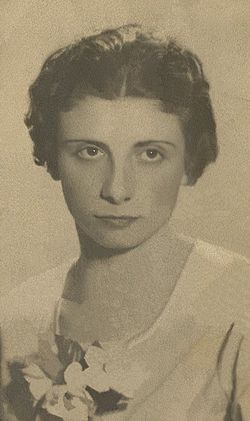Alicia Lourteig facts for kids
Quick facts for kids
Alicia Lourteig
|
|
|---|---|
 |
|
| Born | 17 December 1913 |
| Died | 30 July 2003 |
| Nationality | Argentina |
| Alma mater | University of Buenos Aires |
| Awards | Guggenheim Fellowship |
| Scientific career | |
| Fields | Botany, Taxonomy |
| Author abbrev. (botany) | Lourteig |
Alicia Lourteig (1913–2003) was a very important botanist from Argentina and France. She was known around the world for her special knowledge of a plant family called Oxalidaceae, which includes plants like wood sorrel.
Contents
Who Was Alicia Lourteig?
Alicia Lourteig was born in Buenos Aires, Argentina, in 1913. Her parents came from both France and Argentina. She was a very curious student and first studied pharmacy and biochemistry at the University of Buenos Aires. She earned her highest degree, a doctorate, in 1946.
Alicia's Amazing Career in Botany
Even though Alicia first studied pharmacy, she became a famous botanist. Botanists are scientists who study plants. Alicia was especially good at something called taxonomy. This means she helped to find, name, and classify different types of plants. She was an expert on several plant families, including the Lythraceae, Ranunculaceae, Mayacaceae, and her favorite, the Oxalidaceae.
Working with Plants and Collections
From 1938 to 1947, Alicia worked as a botanist at the Miguel Lillo Institute in Argentina. After that, she moved to the Darwinion Botanic Institute. Her work allowed her to travel and visit many important plant collections, called herbaria, around the world.
She visited places like the Royal Botanic Gardens, Kew in the UK from 1948 to 1950. She also went to herbaria in Stockholm, Copenhagen, Boston, and Washington in the early 1950s. These visits helped her learn even more about plants from different parts of the world.
Moving to France and Global Discoveries
In 1955, Alicia was invited to work for the French National Centre for Scientific Research. She moved to the National Museum of Natural History, France in Paris. There, she became a curator, which means she took care of the museum's large collection of plants from the New World (North and South America).
She helped update important books about French plants and worked on rules for naming plants. Alicia also organized old plant collections made by famous explorers and botanists like Aimé Bonpland and José Celestino Mutis. She became a research associate at the museum in 1979.
Alicia didn't just study plants in museums. She also traveled to collect plants herself! She explored South America and even went to the cold French Antarctic in 1963-1964 and 1969. She was also an editor for a science journal called Lilloa.
Awards and Honors
Alicia Lourteig received many honors for her important work:
- She received the Millennium Award at a big international meeting for botanists.
- A lake in the Kerguelen Islands in French Antarctica is named after her: Lac Alicia.
- A walking path in a nature reserve in Brazil is also named in her honor.
- About 20 different types of plants (both genera and species) have been named after her! Some examples include Alicia from the Malpighiaceae family, Lourteigia from the Asteraceae family, and Lourtella from the Lythraceae family.
See also
 In Spanish: Alicia Lourteig para niños
In Spanish: Alicia Lourteig para niños

